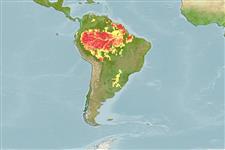Classification / Names
Common names | Synonyms | Catalog of Fishes (gen., sp.) | ITIS | CoL | WoRMS | Cloffa
Actinopterygii (ray-finned fishes) >
Siluriformes (Catfish) >
Aspredinidae (Banjo catfishes) > Bunocephalinae
Etymology: Bunocephalus: Greek, byneo = to fill up, to swell + Greek, kephale = head (Ref. 45335).
Environment / Climate / Range
Ecology
Freshwater; demersal; pH range: 6.0 - 8.0; dH range: 5 - 19. Tropical; 25°C - 28°C (Ref. 30491), preferred ?
South America: Amazon River basin.
Length at first maturity / Size / Weight / Age
Maturity: Lm ?, range 14 - ? cm
Max length : 11.0 cm SL male/unsexed; (Ref. 36695)
Occurs in ponds (Ref. 11229) and forest creeks rich in plant debris (Ref. 35381). Benthic fish which feeds on a wide range of food, including organic debris from the bottom. Spawns eggs on sandy substrate, in groups. Unlike the other species of Aspredinidae, the female does not carry her eggs (4,000 to 5,000 per spawning) in bags (cotylophores). It swims with undulating motion of its body and tail, rhythmically ejecting water from its opercles, thus resulting in a forward propulsion (Ref. 35381). Aquarium keeping: needs fine gravel or sand; minimum aquarium size 80 cm (Ref. 51539).
Spawns in up to 30 cm deep water (Ref.1672).
Friel, J.P., 2003. Aspredinidae (Banjo catfishes). p. 261-267. In R.E. Reis, S.O. Kullander and C.J. Ferraris, Jr. (eds.) Checklist of the Freshwater Fishes of South and Central America. Porto Alegre: EDIPUCRS, Brasil. (Ref. 36695)
IUCN Red List Status (Ref. 115185)
CITES (Ref. 94142)
Not Evaluated
Threat to humans
Harmless
Human uses
Fisheries: of no interest; aquarium: commercial
More information
ReferencesAquacultureAquaculture profileStrainsGeneticsAllele frequenciesHeritabilityDiseasesProcessingMass conversion
Tools
Special reports
Download XML
Internet sources
